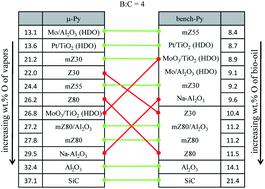当前位置:
X-MOL 学术
›
Sustain. Energy Fuels
›
论文详情
Our official English website, www.x-mol.net, welcomes your
feedback! (Note: you will need to create a separate account there.)
Insights into the scalability of catalytic upgrading of biomass pyrolysis vapors using micro and bench-scale reactors
Sustainable Energy & Fuels ( IF 5.0 ) Pub Date : 2020-05-15 , DOI: 10.1039/d0se00303d Andreas Eschenbacher 1, 2, 3 , Alireza Saraeian 4, 5, 6, 7 , Brent H. Shanks 4, 5, 6, 7 , Peter Arendt Jensen 1, 2, 3 , Ulrik Birk Henriksen 1, 2, 3 , Jesper Ahrenfeldt 1, 2, 3 , Anker Degn Jensen 1, 2, 3
Sustainable Energy & Fuels ( IF 5.0 ) Pub Date : 2020-05-15 , DOI: 10.1039/d0se00303d Andreas Eschenbacher 1, 2, 3 , Alireza Saraeian 4, 5, 6, 7 , Brent H. Shanks 4, 5, 6, 7 , Peter Arendt Jensen 1, 2, 3 , Ulrik Birk Henriksen 1, 2, 3 , Jesper Ahrenfeldt 1, 2, 3 , Anker Degn Jensen 1, 2, 3
Affiliation

|
Despite a vast body of literature dedicated to catalyst screening using micro-scale reactor systems for the catalytic deoxygenation of biomass-derived fast pyrolysis vapors, the quantitative scalability of the results obtained at the microscale to a continuous industrial process remains questionable. In this work, the product yields from ex situ vapor upgrading in a micro-pyrolyzer utilizing mg quantities of catalysts and a bench-scale system using ∼100 g of the catalyst and continuous biomass feeding are compared for nine different catalysts in an inert atmosphere and three different hydrodeoxygenation catalysts in a hydrogen-containing atmosphere. Besides the comparison of product yields, important quality parameters of the bio-oil collected at the bench-scale such as oxygen content, TAN, molar H/C and O/C ratio, effective hydrogen index (EHI), and higher heating value (HHV) were compared with the properties of the non-condensed vapors detected at the micro-scale. A higher deoxygenation severity and HHV and higher yields of CO and light hydrocarbons (both alkanes and alkenes) were measured at the bench-scale compared to the micro-scale. Catalytic vapor upgrading at the bench-scale produced ∼125% more coke per catalyst surface area compared to the micro-pyrolyzer studies, and generally for acidic catalysts tested under an inert atmosphere the yield of aromatics was higher for bench-Py tests compared to μ-Py tests. These differences are attributed to the approximately two orders of magnitude higher catalyst mass/gas flow rate ratios (W/F) applied at the bench-scale compared to the micro-scale, resulting in higher conversions over the catalytic bed and likely additional secondary cracking reactions. At both scales, with an increasing amount of pyrolysis vapors fed over the catalyst the yield of deoxygenated products (aliphatics and monoaromatics) decreased and the selectivity for BTX products decreased when using HZSM-5 containing catalysts. Trends in product selectivity towards aliphatics or aromatics observed for the HDO catalysts tested with the micropyrolyzer agreed with the properties of bio-oil from bench-scale tests. The estimation of the oxygen-content and EHI of the non-condensed vapors at the micro-scale can serve as an indicator for the charring propensity and thus the chemical reactivity of bio-oils obtained at larger scales. Overall, this contribution addresses the implications to consider when applying results obtained at the microscale for catalytic upgrading of fast pyrolysis vapors under an inert or hydrogen-containing atmosphere for predicting the process behavior on a large continuous scale.
中文翻译:

使用微型和台式反应器对生物质热解蒸气催化升级的可扩展性的见解
尽管有大量文献致力于使用微型反应器系统对生物质衍生的快速热解蒸气进行催化脱氧的催化剂筛选,但在微型规模下获得的结果在连续工业过程中的定量可扩展性仍然值得怀疑。在这项工作中,产品易地产生在惰性气氛下,对九种不同的催化剂,在含氢气氛下,对三种不同的加氢脱氧催化剂,对使用毫克量催化剂的微型热解器中的蒸汽提质和使用约100克催化剂并进行连续生物质进料的台式系统进行了比较。 。除了比较产品产量外,还可以在工作台规模上收集重要的生物油质量参数,例如氧含量,TAN,H / C摩尔比和O / C比,有效氢指数(EHI)和较高的发热量(将HHV)与在微观尺度上检测到的非冷凝蒸气的特性进行了比较。与基准规模相比,在实验室规模下测得较高的脱氧严重度和HHV,以及较高的CO和轻烃(烷烃和烯烃)收率。与微型热解器研究相比,台式规模的催化蒸汽提质每催化剂表面积可增加约125%的焦炭,通常对于在惰性气氛下测试的酸性催化剂,台式Py测试的芳烃收率高于μ -Py测试。这些差异归因于催化剂质量/气体流速比高出约两个数量级(w ^ / ˚F)相比于微型规模,在实验室规模上应用,导致催化床的转化率更高,并且可能还会发生其他次级裂解反应。在这两个规模上,随着进料到催化剂上的热解蒸气量的增加,当使用含HZSM-5的催化剂时,脱氧产物(脂肪族和单芳香族)的收率下降,对BTX产物的选择性下降。用微型热解仪测试的HDO催化剂观察到的产品对脂肪族或芳香族化合物选择性的趋势与台式试验中生物油的特性一致。微观尺度上非冷凝蒸气的含氧量和EHI的估算可以作为炭化倾向的指标,因此可以作为较大规模获得的生物油化学反应的指标。总体,
更新日期:2020-06-30
中文翻译:

使用微型和台式反应器对生物质热解蒸气催化升级的可扩展性的见解
尽管有大量文献致力于使用微型反应器系统对生物质衍生的快速热解蒸气进行催化脱氧的催化剂筛选,但在微型规模下获得的结果在连续工业过程中的定量可扩展性仍然值得怀疑。在这项工作中,产品易地产生在惰性气氛下,对九种不同的催化剂,在含氢气氛下,对三种不同的加氢脱氧催化剂,对使用毫克量催化剂的微型热解器中的蒸汽提质和使用约100克催化剂并进行连续生物质进料的台式系统进行了比较。 。除了比较产品产量外,还可以在工作台规模上收集重要的生物油质量参数,例如氧含量,TAN,H / C摩尔比和O / C比,有效氢指数(EHI)和较高的发热量(将HHV)与在微观尺度上检测到的非冷凝蒸气的特性进行了比较。与基准规模相比,在实验室规模下测得较高的脱氧严重度和HHV,以及较高的CO和轻烃(烷烃和烯烃)收率。与微型热解器研究相比,台式规模的催化蒸汽提质每催化剂表面积可增加约125%的焦炭,通常对于在惰性气氛下测试的酸性催化剂,台式Py测试的芳烃收率高于μ -Py测试。这些差异归因于催化剂质量/气体流速比高出约两个数量级(w ^ / ˚F)相比于微型规模,在实验室规模上应用,导致催化床的转化率更高,并且可能还会发生其他次级裂解反应。在这两个规模上,随着进料到催化剂上的热解蒸气量的增加,当使用含HZSM-5的催化剂时,脱氧产物(脂肪族和单芳香族)的收率下降,对BTX产物的选择性下降。用微型热解仪测试的HDO催化剂观察到的产品对脂肪族或芳香族化合物选择性的趋势与台式试验中生物油的特性一致。微观尺度上非冷凝蒸气的含氧量和EHI的估算可以作为炭化倾向的指标,因此可以作为较大规模获得的生物油化学反应的指标。总体,









































 京公网安备 11010802027423号
京公网安备 11010802027423号